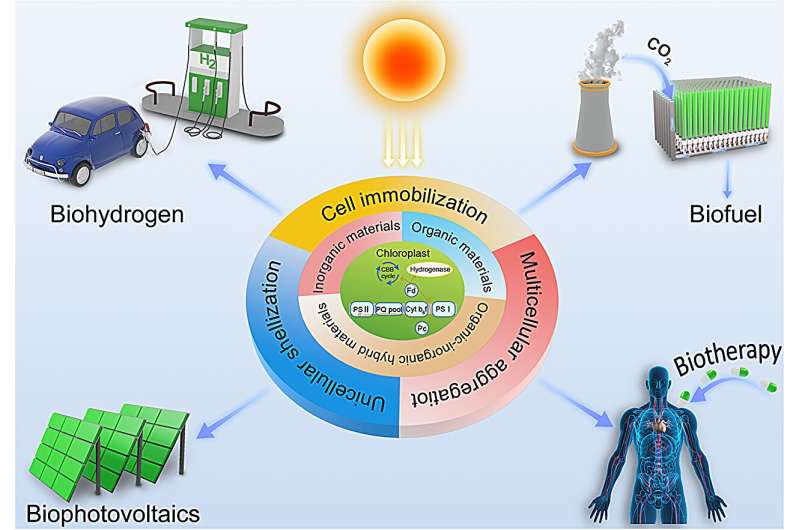
Microalgae-material hybrid offers great prospects in the fields of clean energy, environmental protection, and life health, which contributes to the realization of carbon peaking and carbon neutrality. Credit: Science China Press
Microalgae, including cyanobacteria and green algae, represent the most important biological systems for producing biomass and high-value products. It is estimated that microalgae can fix about 90 billion tons of carbon dioxide per year, which accounts for more than 40% of the global net photosynthetic carbon fixation.
With the intensification of global warming and the proposal of China’s dual carbon reduction goals, the role of microalgal photosynthesis is getting more and more attention. Therefore, exploiting microalgae photosynthetic energy is a promising approach to energy transition for carbon peak and neutrality.
However, the photosynthetic conversion efficiency is a major limitation of microalgae biofuel production. Generally, only about 4–8% of the light energy can be converted into chemical energy in the form of biomass (the theoretical maximum is 9%). Therefore, the microalgae production for biofuels cannot meet the human energy needs.
Genetic engineering and metabolic engineering can be used to improve microalgal production photosynthetic conversion efficiency, but these methods require complicated operation and high cost with narrow scope of application.
In nature, organisms can form organic-inorganic composite materials with complex structures and excellent biological properties through biomineralization, such as bones, teeth, and shells. These biomaterials have a highly ordered hierarchical structure from the nanoscale to the macroscale, which can provide organisms with functions such as mechanical support, protection, movement, and signal sensing.
Against the backdrop of the natural biomineralization phenomenon, the artificial cell-material hybrid has received increasing interest in green chemistry and engineered living biomaterials. In order to exploit the microalgal photosynthetic energy, scientists have been inspired to interface nature’s photosynthetic organisms with synthetic materials so as to impart the organisms with new properties.
Professor Wei Xiong from Nanchang University (NCU) and Professor Ruikang Tang from Zhejiang University (ZJU) have defined the artificially generated biomorph as microalgae-material hybrid (MMH), which is mainly based upon microscale interactions, such as chemical bonds or noncovalent interactions. Their research is published in the journal National Science Review.
In the recent decade, scientists have explored three material approaches to construct MMH: (i) cell immobilization, (ii) unicellular shellization, (iii) multicellular aggregation.
Materials combine with microalgae through intermolecular forces, covalent bond or coordinate bond, which interfere with the exchange of matter and energy between microalgae and extracellular environment. Microalgae-material interface affect photosynthetic electron transport chain through three principal pathways: (i) material hinder light energy from entering the photosystems to produce photosynthetic electrons, (ii) extracellular electrons enter the cell and involve in photosynthetic electron transport, (iii) extract electrons from the inner surface of the cell. Credit: Science China Press
MMHs have made considerable achievements, including CO2 fixation, H2 production, bioelectrochemical energy conversion, and biomedical therapy. It follows that MMH for biological regulation is becoming an emerging field.
The core problem of MMH is microalgae-material interaction. There are two levels of meaning in microalgae-material interaction; one is the material-induced construction of microalgae-material hybrid, and the other is the material-endowed improvement of microalgal function.
From a perspective of the construction of MMH, the chemical mechanism is microalgae combined with the material through intermolecular forces, covalent bonds, or coordinated bonds to form the biotic–abiotic interface, and the materials affect microalgae functions by interfering with matter and energy transfer between microalgae and the extracellular environment.
Inorganic materials combine with microalgal cells mainly through coordination bonds and intermolecular forces, while organic materials combine with microalgal cells mainly through covalent bonds and intermolecular forces. Apart from MMH construction, microalgae-material interaction in the hybrid structure is the most critical problem.
Based on the previous studies, the researchers propose two mechanisms of material-endowed improvement of microalgal function. One is microalgae-material electron transfer; the other is material-induced cell microenvironment transformation.
At present, the main limitation of MMHs for photosynthetic energy conversion is the low energy conversion efficiency, which makes practical application in carbon neutrality difficult. Besides, the high cost of the microalgae culture and the lack of material technology suitable for the large-scale engineering of microalgae are also important limiting factors for practical application. In the future, improving the energy-conversion efficiency is the general aim for fundamental research.
MMH offers opportunities to boost semi-biohybrid research and synchronously inspires investigation of biotic-abiotic interface manipulation. Research in this area can not only promote the application of chemistry and material in the biological sciences but also provide new perspectives for biological and environmental sciences. Further, this research field may spawn a new discipline, which can be named Material Biology.
Once the photosynthetic energy conversion efficiency is broken through, MMHs can greatly promote the applications of photosynthetic CO2 fixation and H2 production. Finally, there is sufficient reason to believe that the application of a microalgae-material hybrid will greatly contribute to the achievement of carbon neutrality.
More information:
Wei Xiong et al, Microalgae–material hybrid for enhanced photosynthetic energy conversion: a promising path towards carbon neutrality, National Science Review (2023). DOI: 10.1093/nsr/nwad200
Citation:
A microalgae–material hybrid promotes carbon neutrality (2024, March 25)
retrieved 26 March 2024
from https://phys.org/news/2024-03-microalgaematerial-hybrid-carbon-neutrality.html
This document is subject to copyright. Apart from any fair dealing for the purpose of private study or research, no
part may be reproduced without the written permission. The content is provided for information purposes only.
>>> Read full article>>>
Copyright for syndicated content belongs to the linked Source : Phys.org – https://phys.org/news/2024-03-microalgaematerial-hybrid-carbon-neutrality.html
